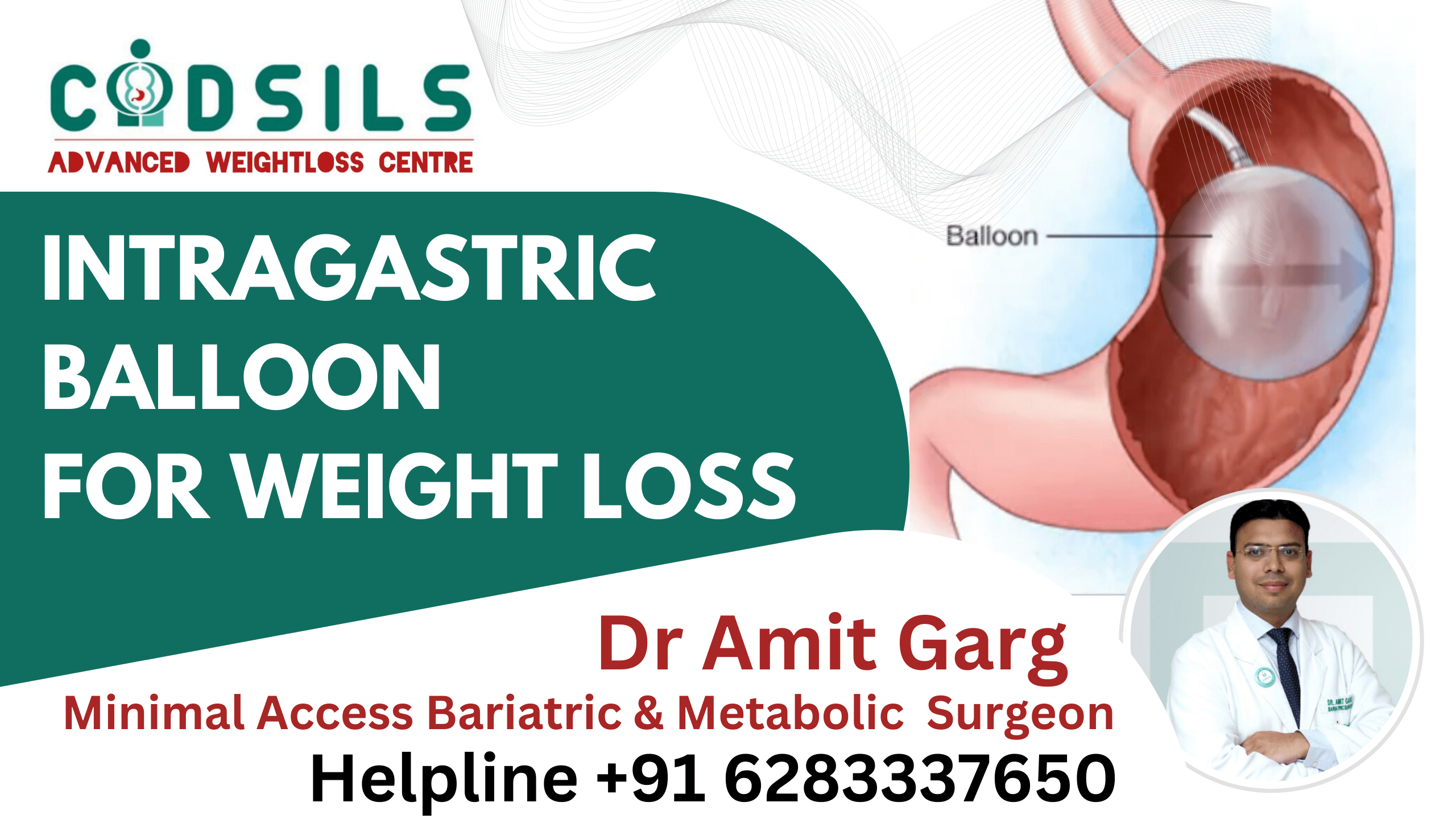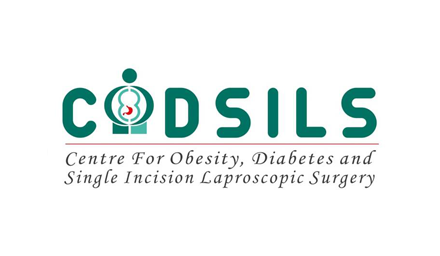
23 Nov Gastric Ballooning For Weight Loss In Mohali India
Gastric Ballooning For Weight Loss In Mohali
The intragastric balloon system is a non-invasive medical solution for weight loss, specifically designed for individuals dealing with obesity. This program integrates sustained dietary and lifestyle modifications with the temporary use of a medical implant. This implant takes the form of an inflatable balloon, which is non-surgically positioned within the stomach (hence the term “intragastric”) by the weight loss surgeon. Its mechanism of action involves occupying space within the stomach, inducing a sense of fullness, and curbing the amount you can consume.
Weight Loss Expectation with a Gastric Balloon
Dr Amit Garg, best weight loss surgeon in Mohali shares, “Typically, individuals can anticipate shedding approximately 10% of their total body weight or roughly 30% of their excess weight through the use of a gastric balloon. This level of weight loss has the potential to significantly improve your health within a relatively short time frame. However, as with any weight loss method, your results can vary based on your adherence to the program. Furthermore, maintaining the weight loss achieved may require continued commitment to the program even after the balloon is removed.”
Procedure Details
Before Intragastric Balloon Placement
- Prior to intragastric balloon placement, you will undergo a comprehensive evaluation by your weight loss surgeon to assess your suitability for the procedure.
- If you are deemed a suitable candidate, a team of medical professionals, including a nutritionist, gastroenterologist, psychologist/psychiatrist, and potentially others, will collaborate to develop a personalized weight loss program tailored to your needs.
Candidates to Avoid the Gastric Balloon
Certain medical conditions may preclude the use of a gastric balloon, including:
- Peptic ulcer disease.
- Hiatal hernia.
- A blood clotting disorder.
- Liver disease.
- Substance use disorder.
- A history of previous gastrointestinal surgery.
Preparing for the Procedure
- Your weight loss program team/ surgeon will inform you about the potential risks, benefits, and alternatives to the procedure and obtain your informed consent.
- In some cases, you may be prescribed acid-blocking medication to prevent acid reflux during and after the procedure.
- A few days before the procedure, you will be instructed to follow a clear liquid diet to empty your stomach.
- On the night before the procedure, you will be advised not to eat or drink anything after midnight.
Intragastric Balloon Insertion
- Most intragastric balloons are inserted using an endoscope, which is a flexible tube with a camera attached.
- The endoscope is introduced through your mouth, passing through your esophagus and into your stomach.
- While most people have this procedure while awake, mild sedation is often administered. Swallowable Gastric Pill Balloon is a newer balloon that can be swallowed, but it still requires endoscopic removal.)
- During the procedure, your gastroenterologist or endoscopic surgeon will examine your esophagus and stomach using the endoscope to ensure the safety of balloon placement.
- The balloon is filled with either sterile saline solution (as is common) or gas (used less frequently). Gas-filled balloons, while less effective for weight loss, may offer greater comfort and are recommended for specific cases.
Post-Procedure
- Your stomach will need time to adjust to the balloon before you can return to your regular diet.
- You will begin with a liquid diet and progressively transition to pureed foods, a soft diet, and finally, a long-term diet designed by your nutritionist.
- Regular contact with your weight loss program team is crucial during this period to support you through the physical and psychological effects of the adjustment.
Duration of the Intragastric Balloon:
- The intragastric balloon remains in place for six months, during which time you will work with your team to make sustainable diet and lifestyle changes.
- The initial three months typically yield the most significant weight loss.
Balloon Removal:
- A second endoscopic procedure is performed to remove the balloon. Sedation and a topical anesthetic or lubricant in your throat are used to ease the removal process.
- The endoscopist punctures the balloon, withdraws the filling, and removes the deflated balloon.
- After the balloon’s removal, your weight loss surgeon team continues to collaborate with you for an additional six months to reinforce your long-term lifestyle changes.
Risks and Benefits
Side Effects of the Intragastric Balloon:
Common mild gastrointestinal symptoms often occur and can be managed with prescribed medication. These symptoms, which usually last for about a week, may include:
- Temporary abdominal pain.
- Temporary sore throat.
- Nausea.
- Indigestion.
- Acid reflux.
- Constipation.
Pain and Discomfort
Discomfort is typically more of a dull sensation than acute pain and is usually transient. Some individuals may experience more noticeable discomfort in the first week following the procedure, which can be alleviated with medication.
Risks Associated with the Gastric Balloon
Serious complications are infrequent but can arise. Potential risks encompass:
- Persistent gastrointestinal symptoms: Occurring in less than 3% of cases, these symptoms extend beyond the first week and are not relieved by medication. Additional endoscopy may be required to investigate and potentially adjust or remove the balloon.
- Hyperinflation: Spontaneous hyperinflation affects slightly over 2% of individuals, resulting in balloon malfunction and overinflation after the initial placement. This may lead to persistent gastrointestinal symptoms, necessitating early balloon removal.
- Deflation: In roughly 1.5% of cases, balloon rupture or deflation can cause migration into the intestines. While most migrated balloons safely pass through, there is a risk of obstruction, requiring an emergency procedure.
- Acute pancreatitis: It is believed that the pressure from the balloon inside the stomach can impinge on the pancreas, causing inflammation. If the balloon is the cause, removal is necessary.
- Ulceration: While intragastric balloons are designed with soft, smooth silicone to prevent stomach irritation, ulcers can still occur. They may result from pressure at the bottom of the stomach where the balloon rests. Some individuals may also develop esophageal ulcers due to injury during balloon placement or removal. An unhealed ulcer can potentially lead to gastrointestinal perforation, a life-threatening condition. The risk of gastrointestinal perforation is 0.1%.
Weight Loss Outcomes with the Intragastric Balloon
The intragastric balloon typically results in a substantial weight loss for most individuals, alleviating numerous physical and psychological challenges associated with obesity. Achieving an average weight loss of 10% exceeds what many can attain through lifestyle changes alone. This transformation can serve as a powerful motivator for individuals to sustain their weight loss journey.
Dr Amit Garg, best weight loss surgeon in Mohali, shares that it’s important to recognize that the procedure is not a permanent solution, and there’s no inherent barrier to prevent weight regain after program completion. Current research indicates that only a minority of individuals maintain their intragastric balloon-induced weight loss over a five-year period. Some opt for repeat procedures with the balloon, while others pursue medications or weight loss surgery for a more enduring solution.
Dr. Amit Garg, Founder and Director of CODSILS, is widely recognized as a leading expert in advanced laparoscopic and robotic weight loss surgery. His reputation stems from pioneering contributions to bariatric surgery and his exceptional expertise. In 2014, he founded CODSILS with a vision to provide top-tier solutions for obesity and diabetes, a dream that has flourished and grown significantly over the years.
You can reach Dr Amit Garg – Best surgical and non surgical Weight Loss expert in Mohali, India via email atcodsils.info@gmail.com or call at helpline number +91 6283337650


